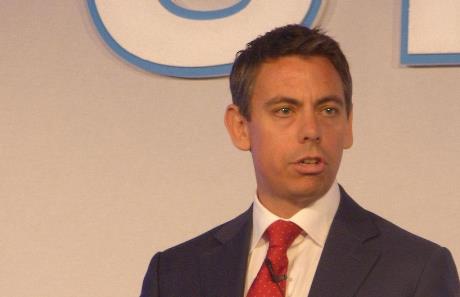The nuclear industry has many opportunities to build a sustainable and competent workforce to avoid a future skills shortage, Callum Thomas, CEO of recruitment consultants Thomas Thor Associates told delegates at the World Nuclear Association's Symposium in London.
 |
| Callum Thomas speaking at the World Nuclear Association's Symposium |
Citing figures from a 2012 report from the European Human Resources Observatory for Nuclear (EHRO-N) - part of the European Commission - Thomas said that in 2011 there were around 500,000 people working in the nuclear industry in the EU, of which 80,000 were classed as "nuclear experts". However, half of these experts are due to retire by 2020. The report forecasts that in 2020 there will be only 63,000 experts leading to a skills gap in the industry.
However, he noted, "In terms of global data on how many people will be needed, there isn't much in terms of reliable data and that makes it really difficult to bring the matter to the fore and get people to really concentrate on it."
Thomas cited projections from the World Nuclear Association for the number of power reactors currently in operation, being decommissioned or under construction, as well as forecast to 2020 and 2030. He noted an increase initially in plants in decommissioning and new plants under construction, but in the longer term there will be more plants operating, more in decommissioning and "the next wave of nuclear new build will be coming through".
He also noted that there is a big shift in activity from Western Europe and North America through to Asia. "But the bottom line is, on a global level, the demand for skills in nuclear professionals is increasing," Thomas said.
He said that the supply of new entrants into the workforce is currently lower than demand due to several factors. These include uncertainty by organizations of the number of people they will need to hire because "they don't know which projects will go ahead and which will not". This makes it difficult to make those "important and expensive decisions". Also, those workers retiring are not being replaced quickly enough and there is a lack of diversity in the industry, with the majority of workers being men aged between 40 and 60.
There are many reasons for acting now on human resources, Thomas told delegates. Firstly, there is competition, he said. It is important to build awareness about the interesting, long-term career opportunities in the nuclear industry. Secondly, there is a timing element. Some roles in the industry - such as plant operations and high-spec technical roles like welding - require up to 10 years of training.
"The good news is there are a lot of opportunities for the industry," Thomas said. For example, it can promote the long-term, secure opportunities it offers. It can also create attractive working environments and flexible working conditions, as well as attractive and innovative remuneration and benefits packages. The industry can also develop programs to attract more women and staff from overseas. It should also consider recruiting professionals from other high safety culture industries.
Cooperation within the industry also offers workers more opportunities to use their skills, Thomas said. There are also advantages in pooling resources, he added. "Working together will prevent people leaving the industry."
"There is a huge opportunity to tap into the rest of the available workforce, i.e. younger people, women and the international community of engineers and technicians and project people," Thomas noted.
Thomas recently chaired a meeting with leaders of nuclear industry and international organization who agreed that there was value in a global working group to share information and effort on building the workforce. As a result an informal group will be set up, initially on LinkedIn, where information can be shared for attracting, recruiting, developing and retaining people in nuclear.
If the group is successful, it will become more formal, organizing seminars and other events, Thomas said.
Researched and written
by World Nuclear News





_18570.jpg)
_16159.jpg)
_49205.jpg)





